Kubernetes and Kubeflow
Let’s start with some basic concepts and go to Kubernetes and Kubeflow later.
Microservices:
Microservices are an architectural approach to building applications where multiple pieces of an app work independently while together. They have the following characteristics:
- separate business logic functions
- instead of one big program, several smaller applications
- communicate via well defined APIs - usually HTTP
- works in demand
Monolithic architecture versus microservices architecture
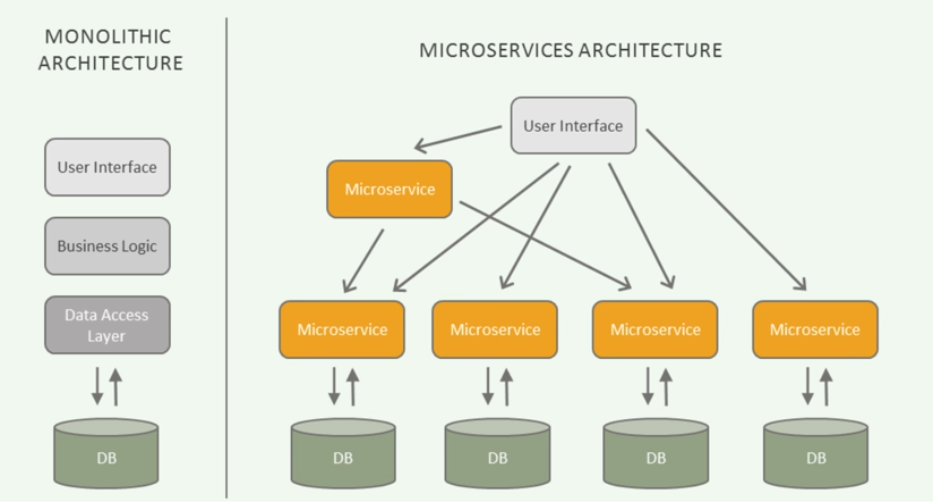
Advantages of Microservices:
- language independent (microservices commuicate via HTTP, so that different microservices can be written in different programming languages)
- fast iterations
- small teams (smaller projects –> smaller teams)
- fault isolation (one fail, won’t intervene other microservices)
- pair well with containers
- SCALABLE (big plus, can scale up or down in demand)
Disadvantages of Microservices:
- complex networking (many microservices communicate with each other, big and complicated network)
- overhead (need to know the architecture to organize and orchestrate things, dynamically spin up databases, containanization)
Docker
Docker is an open platform for developers and sysadmins to build, ship and deliver software in packages called containers, whether on laptops, data center virtual machines, or the cloud.
Containers are a way to package software in a format that can run isolated on a shared operating system. Unlike virtual machines, containers do not bundle a full operating system – only libraries and settings required to make the software work are needed.
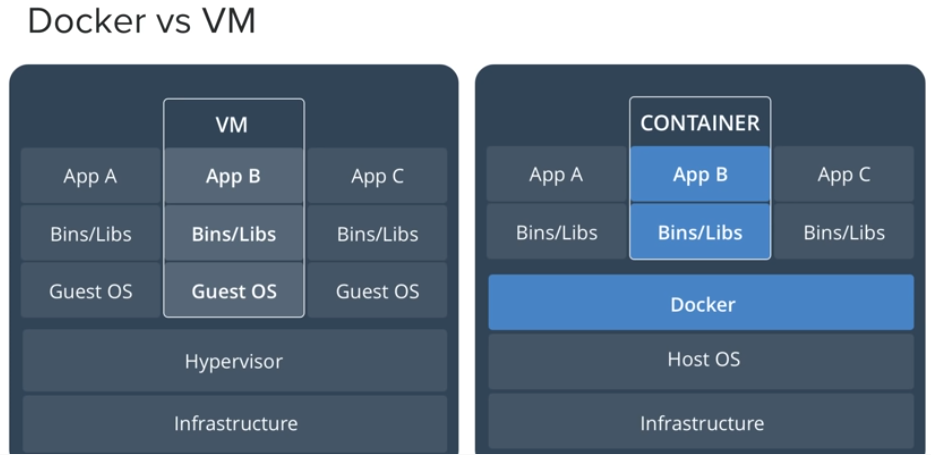
Containers can share bins and libraries.
Once an app is built, add a Dockerfile into the app folder to create an image of the app.
Kubernetes
Container orchestration (deploying and scaling containers)
Kubernetes is an open-source system for automating deployment, scaling, and management of containerized applications.
You will get all the benefit of Kubernetes if you build your applications as microservices.
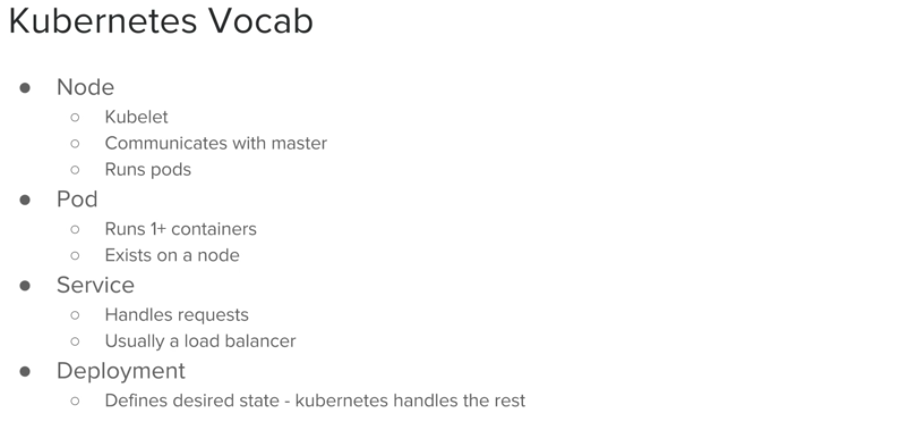
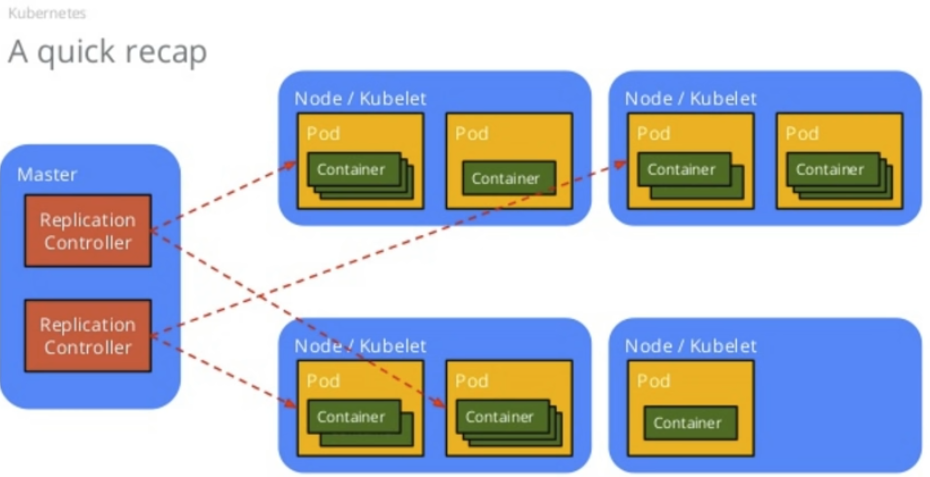
- If a pod gets deleted or failed, Kubernetes will automatically create a new pod.
- It can be scaled up or down very easily by creating or deleting some pods.
- It also provides a friendly GUI called dashboard to allow user-friendly operations of the Kubernetes cluster.
Deploy Docker container in Kubernetes
It requires a separate Yaml file in the app folder which includes all deployment parameters for deployment
An example file directory looks like the following:
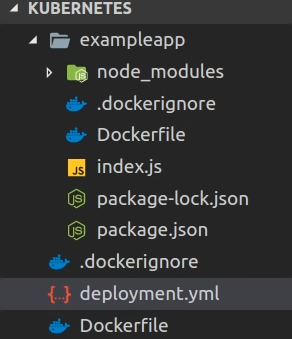
Spin up a Kubernetes cluster –> Download the image from the Dockerhub –> Spin the image up in the pods (deploy the image) –> make the portal open to public (optional)
How does Kubernetes work?
master: manage, plan, schedule and monitor nodes
- ETCD Cluster: store information about the cluster at key-value store
- Kube-scheduler: scheduling applications/nodes/containers
- Controller-manager (i.e., node controller, replication controller)
- Kube-apiserver: responsible for orchestrating all operations in the cluster
worker nodes: host applications as containers
- Kubelet (captain of each worker node, listen for instructions from the kube-apiserver, and manage (destroy or create) containers)
- Docker
- Kube-proxy service (help enabling communication between different services)
- Pod: a collection of containers in a single machine
ref: https://www.youtube.com/watch?v=8C_SCDbUJTg
Kubeflow
Kubeflow is the machine learning toolkit for Kubernetes. Kubernetes is an open-source platform for running and orchestrating containers.
- Portability: Easy, repeatable, portable deployments on a diverse infrastructure (for example, experimenting on a laptop, then moving to an on-premises cluster or to the cloud); all components are containized.
- Comportability: Deploying and managing loosely-coupled microservices
- Scalability: Scaling based on demand
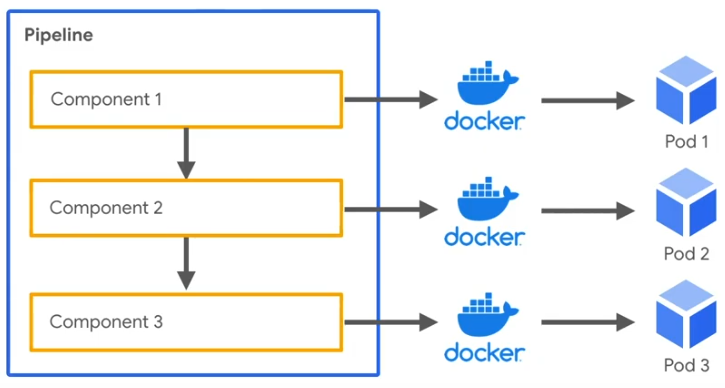
Kubeflow vs Airflow
Airflow, developed by Airbnb, is a generic task orchestration platform to programmaticaly author, schedule and monitor data pipelines. It helps solve a key challenge many companies face — scheduling tasks that have many dependencies. It authors workflows as directed acyclic graphs (DAGs) of tasks, which is a set of tasks to perform, where each task has zero or more upstream dependencies while cycles are not allowed. DAGs are set up using Python code, instead of GUI, which makes it much easier to integrate with version control tools such as GitHub. We can also use Kubernetes to create more robust Airflow deployments.
Kubeflow is a machine learning toolkit that runs on Kubernetes. It is dedicated to making machine learning on Kubernetes easy, portable and scalable. Airflow and Kubeflow are primarily classified as “Workflow Manager” and “Machine Learning” tools respectively.
Use Airflow if you need a mature, broad ecosystem that can run a variety of tasks; use Kubeflow if you are using Kubernetes and want a orchestration tool for machine learning.
They also have other competitors, as shown in the graph below.
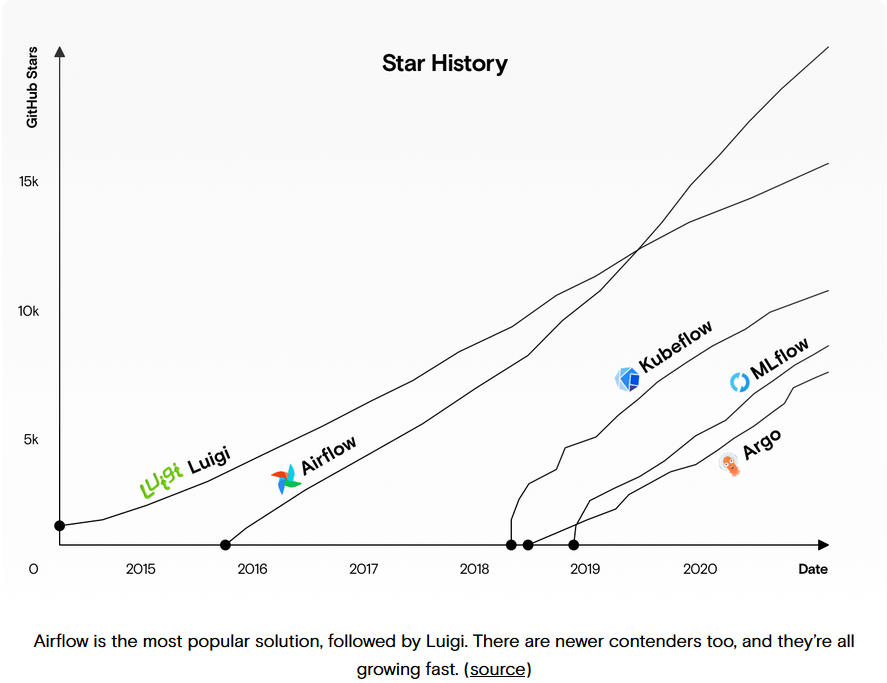
References:
- https://www.kubeflow.org/docs/about/kubeflow/
- https://www.youtube.com/watch?v=1xo-0gCVhTU
- https://stackshare.io/stackups/airflow-vs-kubeflow
- https://www.datarevenue.com/en-blog/airflow-vs-luigi-vs-argo-vs-mlflow-vs-kubeflow
Kubernetes and Kubeflow
Let’s start with some basic concepts and go to Kubernetes and Kubeflow later.
Microservices:
Microservices are an architectural approach to building applications where multiple pieces of an app work independently while together. They have the following characteristics:
- separate business logic functions
- instead of one big program, several smaller applications
- communicate via well defined APIs - usually HTTP
- works in demand
Monolithic architecture versus microservices architecture

Advantages of Microservices:
- language independent (microservices commuicate via HTTP, so that different microservices can be written in different programming languages)
- fast iterations
- small teams (smaller projects –> smaller teams)
- fault isolation (one fail, won’t intervene other microservices)
- pair well with containers
- SCALABLE (big plus, can scale up or down in demand)
Disadvantages of Microservices:
- complex networking (many microservices communicate with each other, big and complicated network)
- overhead (need to know the architecture to organize and orchestrate things, dynamically spin up databases, containanization)
Docker
Docker is an open platform for developers and sysadmins to build, ship and deliver software in packages called containers, whether on laptops, data center virtual machines, or the cloud. Containers are a way to package software in a format that can run isolated on a shared operating system. Unlike virtual machines, containers do not bundle a full operating system – only libraries and settings required to make the software work are needed.

Containers can share bins and libraries. Once an app is built, add a Dockerfile into the app folder to create an image of the app.
Kubernetes
Container orchestration (deploying and scaling containers)
Kubernetes is an open-source system for automating deployment, scaling, and management of containerized applications.
You will get all the benefit of Kubernetes if you build your applications as microservices.


- If a pod gets deleted or failed, Kubernetes will automatically create a new pod.
- It can be scaled up or down very easily by creating or deleting some pods.
- It also provides a friendly GUI called dashboard to allow user-friendly operations of the Kubernetes cluster.
Deploy Docker container in Kubernetes
It requires a separate Yaml file in the app folder which includes all deployment parameters for deployment An example file directory looks like the following:

Spin up a Kubernetes cluster –> Download the image from the Dockerhub –> Spin the image up in the pods (deploy the image) –> make the portal open to public (optional)
How does Kubernetes work?
master: manage, plan, schedule and monitor nodes
- ETCD Cluster: store information about the cluster at key-value store
- Kube-scheduler: scheduling applications/nodes/containers
- Controller-manager (i.e., node controller, replication controller)
- Kube-apiserver: responsible for orchestrating all operations in the cluster worker nodes: host applications as containers
- Kubelet (captain of each worker node, listen for instructions from the kube-apiserver, and manage (destroy or create) containers)
- Docker
- Kube-proxy service (help enabling communication between different services)
- Pod: a collection of containers in a single machine
ref: https://www.youtube.com/watch?v=8C_SCDbUJTg
Kubeflow
Kubeflow is the machine learning toolkit for Kubernetes. Kubernetes is an open-source platform for running and orchestrating containers.
- Portability: Easy, repeatable, portable deployments on a diverse infrastructure (for example, experimenting on a laptop, then moving to an on-premises cluster or to the cloud); all components are containized.
- Comportability: Deploying and managing loosely-coupled microservices
- Scalability: Scaling based on demand

Kubeflow vs Airflow
Airflow, developed by Airbnb, is a generic task orchestration platform to programmaticaly author, schedule and monitor data pipelines. It helps solve a key challenge many companies face — scheduling tasks that have many dependencies. It authors workflows as directed acyclic graphs (DAGs) of tasks, which is a set of tasks to perform, where each task has zero or more upstream dependencies while cycles are not allowed. DAGs are set up using Python code, instead of GUI, which makes it much easier to integrate with version control tools such as GitHub. We can also use Kubernetes to create more robust Airflow deployments.
Kubeflow is a machine learning toolkit that runs on Kubernetes. It is dedicated to making machine learning on Kubernetes easy, portable and scalable. Airflow and Kubeflow are primarily classified as “Workflow Manager” and “Machine Learning” tools respectively.
Use Airflow if you need a mature, broad ecosystem that can run a variety of tasks; use Kubeflow if you are using Kubernetes and want a orchestration tool for machine learning.
They also have other competitors, as shown in the graph below.

References:
- https://www.kubeflow.org/docs/about/kubeflow/
- https://www.youtube.com/watch?v=1xo-0gCVhTU
- https://stackshare.io/stackups/airflow-vs-kubeflow
- https://www.datarevenue.com/en-blog/airflow-vs-luigi-vs-argo-vs-mlflow-vs-kubeflow
Comments
Join the discussion for this article on this ticket. Comments appear on this page instantly.